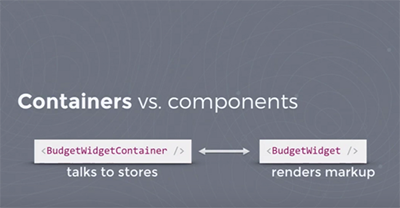жӮЁеҘҪпјҢзҷ»еҪ•еҗҺжүҚиғҪдёӢи®ўеҚ•е“ҰпјҒ
д»ҠеӨ©е°ұи·ҹеӨ§е®¶иҒҠиҒҠжңүе…іжҖҺд№ҲеңЁReactдёӯдёә Vue еј•е…Ҙе®№еҷЁз»„件пјҢеҸҜиғҪеҫҲеӨҡдәәйғҪдёҚеӨӘдәҶи§ЈпјҢдёәдәҶи®©еӨ§е®¶жӣҙеҠ дәҶи§ЈпјҢе°Ҹзј–з»ҷеӨ§е®¶жҖ»з»“дәҶд»ҘдёӢеҶ…е®№пјҢеёҢжңӣеӨ§е®¶ж №жҚ®иҝҷзҜҮж–Үз« еҸҜд»ҘжңүжүҖ收иҺ·гҖӮ
Vueе…·дҪ“иҪ»йҮҸзә§жЎҶжһ¶гҖҒз®ҖеҚ•жҳ“еӯҰгҖҒеҸҢеҗ‘ж•°жҚ®з»‘е®ҡгҖҒ组件еҢ–гҖҒж•°жҚ®е’Ңз»“жһ„зҡ„еҲҶзҰ»гҖҒиҷҡжӢҹDOMгҖҒиҝҗиЎҢйҖҹеәҰеҝ«зӯүдјҳеҠҝпјҢVueдёӯйЎөйқўдҪҝз”Ёзҡ„жҳҜеұҖйғЁеҲ·ж–°пјҢдёҚз”ЁжҜҸж¬Ўи·іиҪ¬йЎөйқўйғҪиҰҒиҜ·жұӮжүҖжңүж•°жҚ®е’ҢdomпјҢеҸҜд»ҘеӨ§еӨ§жҸҗеҚҮи®ҝй—®йҖҹеәҰе’Ңз”ЁжҲ·дҪ“йӘҢгҖӮ
еҒҮеҰӮжҲ‘们иҰҒеҶҷдёҖдёӘ组件жқҘеұ•зӨәиҜ„и®әпјҢеңЁжІЎеҗ¬иҝҮе®№еҷЁз»„件д№ӢеүҚпјҢжҲ‘们зҡ„д»Јз ҒдёҖиҲ¬йғҪжҳҜиҝҷж ·еҶҷзҡ„пјҡ
components/CommentList.vue
<template>
<ul>
<li v-for="comment in comments"
:key="comment.id"
>
{{comment.body}}вҖ”{{comment.author}}
</li>
</ul>
</template>
<script>
export default {
name: 'CommentList',
computed: {
comments () {
return this.$store.state.comments
}
},
mounted () {
this.$store.dispatch('fetchComments')
}
}
</script>store/index.js
import Vue from 'vue'; import Vuex from 'vuex';
Vue.use(Vuex);
const store = new Vuex.Store({
state: {
comments: [],
},
mutations: {
setComments(state, comments) {
state.comments = comments;
},
},
actions: {
fetchComments({commit}) {
setTimeout(() => {
commit('setComments', [
{
body: 'йңёж°”дҫ§жјҸ',
author: 'йӣ·еҸ”',
id: 1123,
},
{
body: 'жңәжҷәеҰӮжҲ‘',
author: 'и•ҫеҰ№',
id: 1124,
},
]);
});
},
},
});export default store;
иҝҷж ·еҶҷзңӢиө·жқҘзҗҶжүҖеҪ“然пјҢжңүжІЎжңүд»Җд№Ҳй—®йўҳпјҢжҲ–иҖ…еҸҜд»ҘдјҳеҢ–зҡ„ең°ж–№е‘ўпјҹ
жңүдёҖдёӘеҫҲжҳҫиҖҢжҳ“и§Ғзҡ„й—®йўҳпјҢз”ұдәҺ CommentList.vue дёҺ йЎ№зӣ®зҡ„ Vuex store дә§з”ҹдәҶиҖҰеҗҲпјҢеҜјиҮҙи„ұзҰ»еҪ“еүҚзҡ„йЎ№зӣ®еҫҲйҡҫеӨҚз”ЁгҖӮ
жңүжІЎжңүжӣҙеҘҪзҡ„组件зҡ„з»„з»Үж–№ејҸпјҢеҸҜд»Ҙи§ЈеҶіиҝҷдёӘй—®йўҳе‘ўпјҹжҳҜж—¶еҖҷдәҶи§ЈдёӢ React зӨҫеҢәзҡ„е®№еҷЁз»„件зҡ„жҰӮеҝөдәҶгҖӮ
д»Җд№ҲжҳҜе®№еҷЁз»„件
еңЁ React.js Conf 2015 пјҢжңүдёҖдёӘ Making your app fast with high-performance components зҡ„дё»йўҳд»Ӣз»ҚдәҶе®№еҷЁз»„件гҖӮ

е®№еҷЁз»„件专门иҙҹиҙЈе’Ң store йҖҡдҝЎпјҢжҠҠж•°жҚ®йҖҡиҝҮ props дј йҖ’з»ҷжҷ®йҖҡзҡ„еұ•зӨә组件пјҢеұ•зӨә组件еҰӮжһңжғіеҸ‘иө·ж•°жҚ®зҡ„жӣҙж–°пјҢд№ҹжҳҜйҖҡиҝҮе®№еҷЁз»„件йҖҡиҝҮ props дј йҖ’зҡ„еӣһи°ғеҮҪж•°жқҘе‘ҠиҜү storeгҖӮ
з”ұдәҺеұ•зӨә组件дёҚеҶҚзӣҙжҺҘе’Ң store иҖҰеҗҲпјҢиҖҢжҳҜйҖҡиҝҮ props жҺҘеҸЈжқҘе®ҡд№үиҮӘе·ұжүҖйңҖзҡ„ж•°жҚ®е’Ңж–№жі•пјҢдҪҝеҫ—еұ•зӨә组件зҡ„еҸҜеӨҚз”ЁжҖ§дјҡжӣҙй«ҳгҖӮ
е®№еҷЁз»„件 е’Ң еұ•зӨә组件 зҡ„еҢәеҲ«
еұ•зӨә组件 | е®№еҷЁз»„件 | |
|---|---|---|
| дҪңз”Ё | жҸҸиҝ°еҰӮдҪ•еұ•зҺ°пјҲйӘЁжһ¶гҖҒж ·ејҸпјү | жҸҸиҝ°еҰӮдҪ•иҝҗиЎҢпјҲж•°жҚ®иҺ·еҸ–гҖҒзҠ¶жҖҒжӣҙж–°пјү |
| зӣҙжҺҘдҪҝз”Ё store | еҗҰ | жҳҜ |
| ж•°жҚ®жқҘжәҗ | props | зӣ‘еҗ¬ store state |
| ж•°жҚ®дҝ®ж”№ | д»Һ props и°ғз”Ёеӣһи°ғеҮҪж•° | еҗ‘ store жҙҫеҸ‘ actions |
жқҘиҮӘ Redux ж–ҮжЎЈ https://user-gold-cdn.xitu.io/2018/5/2/1631f590aa5512b7
з”Ё е®№еҷЁз»„件/еұ•зӨә组件 жЁЎејҸж”№йҖ дёҠйқўзҡ„дҫӢеӯҗ
й’ҲеҜ№жңҖеҲқзҡ„дҫӢеӯҗпјҢеҰӮдҪ•еҝ«йҖҹжҢүз…§иҝҷз§ҚжЁЎејҸжқҘеҲ’еҲҶ组件呢пјҹжҲ‘们主иҰҒй’ҲеҜ№ CommentList.vue иҝӣиЎҢжӢҶеҲҶ,йҰ–е…ҲжҳҜеҹәжң¬зҡ„жҰӮиҰҒи®ҫи®Ўпјҡ
жҰӮиҰҒи®ҫи®Ў
еұ•зӨә组件
components/CommentListNew.vue иҝҷжҳҜдёҖдёӘж–°зҡ„иҜ„и®әеұ•зӨә组件пјҢз”ЁдәҺеұ•зӨәиҜ„и®ә
comments: Array prop жҺҘ收д»Ҙ { id, author, body } еҪўејҸжҳҫзӨәзҡ„ comment йЎ№ж•°з»„гҖӮ
fetch() жҺҘ收жӣҙж–°иҜ„и®әж•°жҚ®зҡ„ж–№жі•
еұ•зӨә组件еҸӘе®ҡд№үеӨ–и§Ӯ并дёҚе…іеҝғж•°жҚ®жқҘжәҗе’ҢеҰӮдҪ•ж”№еҸҳгҖӮдј е…Ҙд»Җд№Ҳе°ұжёІжҹ“д»Җд№ҲгҖӮ
commentsгҖҒfetch зӯүиҝҷдәӣ props 并дёҚе…іеҝғиғҢеҗҺжҳҜеҗҰжҳҜз”ұ Vuex жҸҗдҫӣзҡ„пјҢдҪ еҸҜд»ҘдҪҝз”Ё VuexпјҢжҲ–иҖ…е…¶д»–зҠ¶жҖҒз®ЎзҗҶеә“пјҢз”ҡиҮіжҳҜдёҖдёӘ EventBusпјҢйғҪеҸҜд»ҘеӨҚз”Ёиҝҷдәӣеұ•зӨә组件гҖӮ
еҗҢж—¶пјҢеҸҜд»ҘеҲ©з”Ё props зҡ„зұ»еһӢе’ҢйӘҢиҜҒжқҘзәҰжқҹдј е…Ҙзҡ„еҶ…е®№пјҢжҜ”еҰӮйӘҢиҜҒдј е…Ҙзҡ„ comments жҳҜеҗҰжҳҜдёҖдёӘеҗ«жңүжҢҮе®ҡеӯ—ж®өзҡ„еҜ№иұЎпјҢиҝҷеңЁд№ӢеүҚж··еҗҲ组件зҡ„жғ…еҶөжҳҜдёӢжҳҜжІЎжңүзҡ„пјҢжҸҗй«ҳдәҶд»Јз Ғзҡ„еҒҘеЈ®жҖ§гҖӮ
е®№еҷЁз»„件
containers/CommentListContainer.vue е°Ҷ CommentListNew 组件иҝһжҺҘеҲ° store
е®№еҷЁз»„件еҸҜд»Ҙе°Ҷ store еҜ№еә”зҡ„ state жҲ–иҖ… action зӯүе°ҒиЈ…дј е…Ҙеұ•зӨә组件гҖӮ
зј–з Ғе®һзҺ°
Talk is cheap, show me the code!
components/CommentListNew.vue
иҝҷдёӘж–Ү件дёҚеҶҚдҫқиө– storeпјҢж”№дёәд»Һ props дј йҖ’гҖӮ
еҖјеҫ—жіЁж„ҸеҲ°жҳҜ comments е’Ң fetch еҲҶеҲ«е®ҡд№үдәҶ type гҖҒdefault е’Ң validatorпјҢз”Ёд»Ҙе®ҡд№үе’ҢйӘҢиҜҒ propsгҖӮ
<template>
<ul>
<li v-for="comment in comments"
:key="comment.id"
>
{{comment.body}}вҖ”{{comment.author}}
</li>
</ul>
</template>
<script>
export default {
name: 'CommentListNew',
props: {
comments: {
type: Array,
default () {
return []
},
validator (comments) {
return comments.every(comment =>
'body' in comment &&
'author' in comment &&
'id' in comment
)
}
},
fetch: {
type: Function,
default: () => {}
}
},
mounted () {
this.fetch()
}
}
</script>containers/CommentListContainer.vue
е®№еҷЁз»„件зҡ„иҒҢиҙЈ
йҖҡиҝҮ computed жқҘиҺ·еҸ–еҲ°зҠ¶жҖҒжӣҙж–°пјҢдј йҖ’з»ҷеұ•зӨә组件
йҖҡиҝҮ methods е®ҡд№үеӣһи°ғеҮҪж•°пјҢеӣһи°ғеҮҪж•°еҶ…йғЁи°ғз”Ё store зҡ„ dispatch ж–№жі•пјҢдј йҖ’з»ҷеұ•зӨә组件
<template>
<CommentList
:comments="comments"
:fetch="fetchComments"
></CommentList>
</template>
<script>
import CommentList from '@/components/CommentListNew'
export default {
name: 'CommentListContainer',
components: {
CommentList
},
computed: {
comments () {
return this.$store.state.comments
}
},
methods: {
fetchComments () {
return this.$store.dispatch('fetchComments')
}
}
}
</script>дҪҝз”Ё @xunlei/vuex-connector е®һзҺ°е®№еҷЁз»„件
дёҠйқўжј”зӨәзҡ„е®№еҷЁз»„件зҡ„д»Јз Ғйқһеёёз®ҖеҚ•пјҢе®һйҷ…дёҠеҰӮжһңзӣҙжҺҘжҠ•е…Ҙз”ҹдә§зҺҜеўғпјҢдјҡдә§з”ҹдёҖдәӣй—®йўҳгҖӮ
жүӢеҠЁе®һзҺ°е®№еҷЁз»„件еӯҳеңЁзҡ„дёҚи¶і
д»Јз ҒжҜ”иҫғз№Ғзҗҗ
еңЁдёҠйқўзҡ„дҫӢеӯҗдёӯпјҢжҜҸж¬Ўдј йҖ’дёҖдёӘ state йғҪиҰҒе®ҡд№үдёҖдёӘ computedпјҢжҜҸдј йҖ’дёҖдёӘ mutation жҲ–иҖ… action йғҪйңҖиҰҒе®ҡдёҖдёӘж–№жі•пјҢиҖҢдё”иҝҳиҰҒжіЁж„ҸиҝҷдёӘж–№жі•зҡ„еҸӮж•°иҰҒйҖҸдј иҝҮеҺ»пјҢеҗҢж—¶иҝҳиҰҒеӨ„зҗҶиҝ”еӣһеҖјпјҢжҜ”еҰӮејӮжӯҘзҡ„ action йңҖиҰҒиҝ”еӣһ promise зҡ„ж—¶еҖҷпјҢе®ҡд№үзҡ„иҝҷдёӘ method д№ҹеҫ—жҠҠ action зҡ„иҝ”еӣһеҖјиҝ”еӣһеҮәеҺ»гҖӮ
ж— жі•йҖҸдј е…¶д»– props з»ҷеұ•зӨә组件
жҜ”еҰӮеұ•зӨә组件新еўһдәҶдёҖдёӘ prop еҸ«еҒҡ typeпјҢеҸҜд»Ҙдј йҖ’дёҖдёӘиҜ„и®әзҡ„зұ»еһӢпјҢз”ЁжқҘеҢәеҲҶжҳҜзғӯй—ЁиҝҳжҳҜжңҖж–°пјҢеҰӮжһңз”ЁдёҠйқўзҡ„е®№еҷЁе®һзҺ°ж–№ејҸпјҢйҰ–е…ҲйңҖиҰҒеңЁе®№еҷЁз»„件иҝҷеұӮж–°еўһдёҖдёӘ prop еҸ«еҒҡ type жҺҘеҸ—еӨ–йғЁдј жқҘзҡ„еҸӮж•°пјҢ然еҗҺеңЁеұ•зӨә组件еҶ…йғЁеҗҢж ·е®ҡд№үдёҖдёӘ еҸ«еҒҡ type зҡ„ propпјҢ然еҗҺжүҚиғҪдј йҖ’дёӢеҺ»гҖӮ
йңҖиҰҒйҖҸдј зҡ„ prop еҝ…йЎ»е®ҡд№үдёӨйҒҚпјҢеўһеҠ дәҶз»ҙжҠӨзҡ„жҲҗжң¬гҖӮ
<CommentListContainer type="зғӯй—Ё"></CommentListContainer> <CommentList :fetch="fetchComments" :comments="comments" :type="type" ></CommentList>
е®№еҷЁз»„д»¶ж— жі•з»ҹдёҖиҝӣиЎҢдјҳеҢ–
жҜҸдёҖдёӘжүӢеҠЁе®һзҺ°зҡ„е®№еҷЁз»„件е®һиҙЁдёҠд»Јз ҒйҖ»иҫ‘йқһеёёиҝ‘дјјпјҢдҪҶжҳҜжІЎжңүз»ҸиҝҮеҗҢдёҖеұӮе°ҒиЈ…пјҢеҰӮжһңзӣ®еүҚе®һзҺ°зҡ„е®№еҷЁз»„件еӯҳеңЁдёҖдәӣжҖ§иғҪдјҳеҢ–зҡ„ең°ж–№пјҢйңҖиҰҒжҜҸдёӘе®№еҷЁз»„件йғҪиҝӣиЎҢз»ҹдёҖзҡ„дҝ®ж”№гҖӮ
ж— жі•жҺ§еҲ¶еұ•зӨә组件дёҚеҺ»иҺ·еҸ– store
еӣ дёәе®№еҷЁз»„件жҳҜйҖҡиҝҮ this.$store иҺ·еҸ– store зҡ„пјҢеұ•зӨә组件еҶ…йғЁе®һиҙЁдёҠд№ҹеҸҜд»ҘзӣҙжҺҘи·ҹ store йҖҡдҝЎпјҢеҰӮжһңжІЎжңүзәҰжқҹпјҢеҫҲйҡҫз»ҹдёҖиҰҒжұӮеұ•зӨә组件дёҚеҫ—зӣҙжҺҘе’Ң store йҖҡдҝЎгҖӮ
дҪҝз”Ё @xunlei/vuex-connector
@xunlei/vuex-connector еҖҹйүҙдәҶ react redux зҡ„ connect ж–№жі•пјҢеңЁ vuex еҹәзЎҖдёҠиҝӣиЎҢзҡ„ејҖеҸ‘гҖӮ
жңүд»ҘдёӢеҮ дёӘзү№зӮ№пјҡ
д»Јз Ғйқһеёёз®ҖжҙҒ
дёӢйқўжҳҜдёҠйқўдҫӢеӯҗдёӯжүӢеҠЁе®һзҺ°зҡ„е®№еҷЁз»„件зҡ„ж”№йҖ зүҲжң¬пјҡ
comonents/ConnectCommentListContainer.vue
<script>
import CommentListNew from '@/components/CommentListNew'
import { connector } from '@/store'
export default connector.connect({
mapStateToProps: {
comments: (state) => state.comments
},
mapActionToProps: {
fetch: 'fetchComments'
}
})(CommentListNew)
</script>йҖҡиҝҮ connector зҡ„ connnect ж–№жі•пјҢдј е…ҘиҰҒжҳ е°„зҡ„й…ҚзҪ®пјҢж”ҜжҢҒ mapStateToProps, mapGettersToProps, mapDispatchToProps, mapCommitToProps иҝҷеӣӣз§ҚпјҢжҜҸдёҖз§ҚйғҪжҳҜеҸӘиҰҒй…ҚзҪ®дёҖдёӘз®ҖеҚ•зҡ„ map еҮҪж•°пјҢжҲ–иҖ…еӯ—з¬ҰдёІеҚіеҸҜгҖӮ
然еҗҺеңЁиҝ”еӣһзҡ„еҮҪж•°дёӯдј е…ҘиҰҒиҝһжҺҘзҡ„еұ•зӨә组件пјҢжҳҜдёҚжҳҜйқһеёёзҡ„з®ҖжҙҒпјҢеҗҢж—¶еҖҹйүҙдәҶ redux дјҳйӣ…зҡ„еҮҪж•°ејҸйЈҺж јгҖӮ
й—®йўҳжқҘдәҶпјҢconnector жҳҜд»Җд№Ҳпјҹ
connector е®һйҷ…дёҠжҳҜдёҖдёӘиғҪиҺ·еҸ–еҲ° store е®һдҫӢзҡ„иҝһжҺҘеҷЁпјҢеҸҜд»ҘеңЁеҲқе§ӢеҢ– vuex store зҡ„ж—¶еҖҷиҝӣиЎҢеҲқе§ӢеҢ–гҖӮ
import Vue from 'vue';
import Vuex from 'vuex';
import VuexConnector from '@xunlei/vuex-connector';
Vue.use(Vuex);
const store = new Vuex.Store({
// your store
});
export const connector = new VuexConnector(store);
export default store;дёҖдёӘ Vue зЁӢеәҸе®һйҷ…дёҠеҸӘйңҖиҰҒеҲқе§ӢеҢ–дёҖж¬ЎеҚіеҸҜгҖӮ
ж”ҜжҢҒйҖҸдј е…¶д»– props з»ҷеұ•зӨә组件
VuexConnector е®һзҺ°зҡ„ж—¶еҖҷйҮҮз”ЁдәҶеҮҪж•°ејҸ组件( functional: true )
еҮҪж•°ејҸ组件жҳҜж— зҠ¶жҖҒ (жІЎжңүе“Қеә”ејҸж•°жҚ®)пјҢж— е®һдҫӢ (жІЎжңү this дёҠдёӢж–Ү)гҖӮ
еңЁдҪңдёәеҢ…装组件时еҮҪж•°ејҸ组件йқһеёёжңүз”ЁпјҢжҜ”еҰӮпјҢеҪ“дҪ йңҖиҰҒеҒҡиҝҷдәӣж—¶пјҡ
зЁӢеәҸеҢ–ең°еңЁеӨҡдёӘ组件дёӯйҖүжӢ©дёҖдёӘ
еңЁе°Ҷ children, props, data дј йҖ’з»ҷеӯҗ组件д№ӢеүҚж“ҚдҪңе®ғ们гҖӮ
еҸҰеӨ–пјҢеҮҪж•°ејҸ组件еҸӘжҳҜдёҖдёӘеҮҪж•°пјҢжүҖд»ҘжёІжҹ“ејҖй”Җд№ҹдҪҺеҫҲеӨҡгҖӮ然иҖҢпјҢеҜ№жҢҒд№…еҢ–е®һдҫӢзҡ„зјәд№Ҹд№ҹж„Ҹе‘ізқҖеҮҪж•°ејҸ组件дёҚдјҡеҮәзҺ°еңЁ Vue devtools зҡ„з»„д»¶ж ‘йҮҢгҖӮ
еӣ жӯӨйңҖиҰҒйҖҸдј зҡ„ props еҸҜд»ҘзӣҙжҺҘйҖҸдј пјҢйңҖиҰҒйҖҡиҝҮ map ж–№ејҸд»Һ store йҮҢиҝӣиЎҢиҺ·еҸ–зҡ„ props зӣҙжҺҘдјҡж №жҚ®й…ҚзҪ®з”ҹжҲҗгҖӮ
з»ҹдёҖе°ҒиЈ…ж–№дҫҝеҗҺз»ӯз»ҹдёҖдјҳеҢ–
VuexConnector.connect ж–№жі•е°Ҷжң¬жқҘйңҖиҰҒйҮҚеӨҚеҒҡзҡ„дәӢжғ…иҝӣиЎҢдәҶжҠҪиұЎпјҢд№ҹеёҰжқҘдәҶеҗҺжңҹиҝӣиЎҢз»ҹдёҖдјҳеҢ–е’ҢеҚҮзә§зҡ„дҫҝеҲ©гҖӮ
еҸҜд»ҘжҺ§еҲ¶еұ•зӨәз»„д»¶ж— жі•зӣҙжҺҘдёҺ store йҖҡдҝЎ
VuexConnector дёҚдҫқиө– this.$storeпјҢиҖҢжҳҜдҫқиө–еҲқе§ӢеҢ–дј е…Ҙзҡ„ store е®һдҫӢпјҢе®№еҷЁз»„件еҸҜд»Ҙз”Ё connect е°Ҷеұ•зӨә组件дёҺ store иҝӣиЎҢиҝһжҺҘгҖӮ
з”ұдәҺдёҚдҫқиө– this.$storeпјҢжҲ‘们еңЁзЁӢеәҸе…ҘеҸЈ new Vue зҡ„ж—¶еҖҷпјҢе°ұдёҚйңҖиҰҒдј е…Ҙ store е®һдҫӢдәҶгҖӮ
жҜ”еҰӮпјҢд№ӢеүҚжҲ‘们жҳҜйҖҡиҝҮдёӢйқўзҡ„ж–№ејҸиҝӣиЎҢеҲқе§ӢеҢ–пјҡ
import Vue from 'vue';
import App from './App';
import store from './store';
new Vue({
el: '#app',
components: {App},
template: '<App/>',
store,
});дҪҝз”ЁдәҶ VuexConnector д№ӢеҗҺпјҢеңЁжңҖеҲқ new Vue зҡ„ж—¶еҖҷе°ұдёҚйңҖиҰҒд№ҹжңҖеҘҪдёҚиҰҒдј йҖ’ store дәҶпјҢиҝҷж ·е°ұйҒҝе…ҚдәҶ this.$store жіӣж»ҘеҜјиҮҙд»Јз ҒиҖҰеҗҲзҡ„й—®йўҳгҖӮ
еј•е…Ҙе®№еҷЁз»„件/еұ•зӨә组件模ејҸеёҰжқҘзҡ„еҘҪеӨ„
еҸҜеӨҚз”ЁжҖ§
е®№еҷЁз»„件/еұ•зӨә组件зҡ„еҲ’еҲҶпјҢйҮҮз”ЁдәҶеҚ•дёҖиҒҢиҙЈеҺҹеҲҷзҡ„и®ҫи®ЎжЁЎејҸпјҢе®№еҷЁз»„件专门иҙҹиҙЈе’Ң store йҖҡдҝЎпјҢеұ•зӨә组件еҸӘиҙҹиҙЈеұ•зӨәпјҢи§ЈйҷӨдәҶ组件зҡ„иҖҰеҗҲпјҢеҸҜд»ҘеёҰжқҘжӣҙеҘҪзҡ„еҸҜеӨҚз”ЁжҖ§гҖӮ
еҒҘеЈ®жҖ§
з”ұдәҺеұ•зӨә组件е’Ңе®№еҷЁз»„件жҳҜйҖҡиҝҮ prop иҝҷз§ҚжҺҘеҸЈжқҘиҝһжҺҘпјҢеҸҜд»ҘеҲ©з”Ё props зҡ„ж ЎйӘҢжқҘеўһејәд»Јз Ғзҡ„еҸҜйқ жҖ§пјҢж··еҗҲзҡ„组件е°ұжІЎжңүиҝҷз§ҚеҘҪеӨ„гҖӮ
еҸҰеӨ–еҜ№ props зҡ„ж ЎйӘҢеҸҜд»ҘйҮҮеҸ–дёҖдёӢеҮ з§Қж–№ејҸпјҡ
Vue 组件 props йӘҢиҜҒ
еҸҜд»ҘйӘҢиҜҒ props зҡ„зұ»еһӢпјҢй»ҳи®ӨеҸҜд»Ҙж ЎйӘҢжҳҜеҗҰжҳҜд»ҘдёӢзұ»еһӢпјҡ
String
Number
Boolean
Function
Object
Array
Symbol
еҰӮжһңдҪ зҡ„ props жҳҜзұ»зҡ„дёҖдёӘе®һдҫӢпјҢtype д№ҹеҸҜд»ҘжҳҜдёҖдёӘиҮӘе®ҡд№үжһ„йҖ еҷЁеҮҪж•°пјҢдҪҝз”Ё instanceof жЈҖжөӢгҖӮ
еҰӮжһңиҝҳжҳҜдёҚж»Ўи¶ійңҖжұӮпјҢеҸҜд»ҘиҮӘе®ҡд№үйӘҢиҜҒеҮҪж•°пјҡ
// иҮӘе®ҡд№үйӘҢиҜҒеҮҪж•°
propF: {
validator: function (value) {
return value > 10
}
}TypeScript зұ»еһӢзі»з»ҹ
Vue 组件 props йӘҢиҜҒеҜ№дәҺеҜ№иұЎжҲ–иҖ…е…¶д»–еӨҚжқӮзҡ„зұ»еһӢж ЎйӘҢиҝҳжҳҜдёҚеӨӘеҸӢеҘҪпјҢжүҖд»ҘеҫҲеӨҡдәәд№ҹжҺЁиҚҗеӨ§е®¶зҡ„ props е°ҪйҮҸйҮҮеҸ–з®ҖеҚ•зұ»еһӢпјҢдёҚиҝҮеҰӮжһңдҪ жңүеңЁз”Ё TypeScript ејҖеҸ‘ Vue еә”з”ЁпјҢеҸҜд»ҘеҲ©з”Ё TypeScript йқҷжҖҒзұ»еһӢжЈҖжҹҘжқҘеЈ°жҳҺдҪ зҡ„ props гҖӮ
@Component
export default class Hello extends Vue {
@Prop
info: IHelloInfo; // иҝҷйҮҢеҸҜд»Ҙз”ЁдҪ иҮӘе®ҡд№үзҡ„ interface
}еҸҜжөӢиҜ•жҖ§
з”ұдәҺ组件еҒҡзҡ„дәӢжғ…жӣҙе°‘дәҶпјҢдҪҝеҫ—жөӢиҜ•д№ҹдјҡеҸҳеҫ—е®№жҳ“гҖӮ
е®№еҷЁз»„件дёҚз”Ёе…іеҝғ UI зҡ„еұ•зӨәпјҢеҸӘе…іеҝғж•°жҚ®е’Ңжӣҙж–°гҖӮ
еұ•зӨә组件еҸӘжҳҜе‘ҲзҺ°дј е…Ҙзҡ„ props пјҢеҶҷеҚ•е…ғжөӢиҜ•зҡ„ж—¶еҖҷд№ҹйқһеёёе®№жҳ“ mock ж•°жҚ®еұӮгҖӮ
еј•е…Ҙе®№еҷЁз»„件/еұ•зӨә组件模ејҸеёҰжқҘзҡ„йҷҗеҲ¶
еӯҰд№ е’ҢејҖеҸ‘жҲҗжң¬
еӣ дёәе®№еҷЁз»„件/еұ•зӨә组件зҡ„жӢҶеҲҶпјҢеҲқжңҹдјҡеўһеҠ дёҖдәӣеӯҰд№ жҲҗжң¬пјҢдёҚиҝҮеҪ“дҪ зңӢе®ҢиҝҷзҜҮж–Үз« пјҢеҹәжң¬дёҠд№ҹе°ұе…Ҙй—ЁдәҶгҖӮ
еңЁејҖеҸ‘зҡ„ж—¶еҖҷпјҢз”ұдәҺйңҖиҰҒе°ҒиЈ…дёҖдёӘе®№еҷЁпјҢеҢ…иЈ…дёҖдәӣж•°жҚ®е’ҢжҺҘеҸЈз»ҷеұ•зӨә组件пјҢдјҡеўһеҠ дёҖдәӣе·ҘдҪңйҮҸпјҢ @xunlei/vuex-connector йҖҡиҝҮй…ҚзҪ®зҡ„ж–№ејҸеҸҜд»ҘеҮҸиҪ»дёҚе°‘дҪ зҡ„е·ҘдҪңйҮҸгҖӮ
еҸҰеӨ–пјҢеңЁеұ•зӨә组件еҶ…еҜ№ props зҡ„еЈ°жҳҺд№ҹдјҡеёҰжқҘе°‘йҮҸзҡ„е·ҘдҪңгҖӮ
жҖ»дҪ“жқҘиҜҙпјҢеј•е…Ҙе®№еҷЁз»„件/еұ•зӨә组件模ејҸжҠ•е…Ҙдә§еҮәжҜ”иҝҳжҳҜжҜ”иҫғеҖјеҫ—зҡ„гҖӮ
зңӢе®ҢдёҠиҝ°еҶ…е®№пјҢдҪ 们еҜ№жҖҺд№ҲеңЁReactдёӯдёә Vue еј•е…Ҙе®№еҷЁз»„件жңүиҝӣдёҖжӯҘзҡ„дәҶи§Јеҗ—пјҹеҰӮжһңиҝҳжғідәҶи§ЈжӣҙеӨҡзҹҘиҜҶжҲ–иҖ…зӣёе…іеҶ…е®№пјҢиҜ·е…іжіЁдәҝйҖҹдә‘иЎҢдёҡиө„и®Ҝйў‘йҒ“пјҢж„ҹи°ўеӨ§е®¶зҡ„ж”ҜжҢҒгҖӮ
е…ҚиҙЈеЈ°жҳҺпјҡжң¬з«ҷеҸ‘еёғзҡ„еҶ…е®№пјҲеӣҫзүҮгҖҒи§Ҷйў‘е’Ңж–Үеӯ—пјүд»ҘеҺҹеҲӣгҖҒиҪ¬иҪҪе’ҢеҲҶдә«дёәдё»пјҢж–Үз« и§ӮзӮ№дёҚд»ЈиЎЁжң¬зҪ‘з«ҷз«ӢеңәпјҢеҰӮжһңж¶үеҸҠдҫөжқғиҜ·иҒ”зі»з«ҷй•ҝйӮ®з®ұпјҡis@yisu.comиҝӣиЎҢдёҫжҠҘпјҢ并жҸҗдҫӣзӣёе…іиҜҒжҚ®пјҢдёҖз»ҸжҹҘе®һпјҢе°Ҷз«ӢеҲ»еҲ йҷӨж¶үе«ҢдҫөжқғеҶ…е®№гҖӮ
жӮЁеҘҪпјҢзҷ»еҪ•еҗҺжүҚиғҪдёӢи®ўеҚ•е“ҰпјҒ